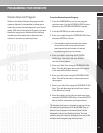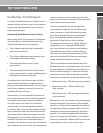
NAUTILUS
®
FIT TEST PROGRAM
23
TEST YOUR FITNESS LEVEL
The Nautilus
®
Fit Test Program
It is helpful to periodically test your fi tness level to
measure the success level of your current workout
program and make adjustments to your exercise
program going forward.
Understanding Sub-Maximal Exercise Testing
Before using the Fit Test Program for sub-maximal
exercise testing, it should be noted that all sub-
maximal tests make several assumptions:
• That a steady-state heart rate is obtained for
each exercise workload.
• That a linear relationship exists between heart
rate, oxygen uptake and workload.
• That the maximal heart rate for a given
age is uniform.
• That the mechanical effi ciency of the physical
activity performed (i.e., oxygen uptake at a given
workload) is the same for everyone.
It should be kept in mind that any one or all of the
above mentioned assumptions might not be met
during a sub-maximal exercise test. If for any reason
one of the assumptions is not met, then errors in
predicting VO2 max will occur.
Unfortunately, it is often quite diffi cult to meet all
of the requirements for the four listed assumptions.
For example, exercising at a given workload for
only a few minutes can involve an insuffi cient
amount of time for many individuals to achieve a
true steady state. To ensure that a steady state has
been achieved, the heart rate should be measured
after two minutes of exercise at a given workload
and again after the third minute of exercise at that
workload. These two heart rates should then be
compared. If a difference of more than fi ve beats per
minute between the two is found, the person should
continue to exercise at one-minute intervals at the
same workload until two successive heart rates differ
by less than fi ve beats per minute.
It is also important that the sub-maximal heart
rates obtained be between 115 and 150 beats per
minute, because it is within this heart rate range
that a linear relationship tends to exist between
heart rate and oxygen uptake or workload for
most adults. When the heart rate is less than
115, many external factors (e.g., talking, laughing,
apprehension, etc.) can greatly infl uence heart
rate. Once the heart rate reaches a level between
115 and 150, external factors no longer infl uence
heart rate, and a linear relationship exists. As the
heart rate rises above 150, the heart rate/oxygen
uptake relationship becomes curvilinear.
The third assumption involves maximal heart rate.
Maximal heart rate is the greatest heart rate that can
be measured when an individual is exercising to the
point of volitional fatigue (i.e., exhaustion) during a
graded exercise test. Several equations have been
developed to estimate an average maximal heart rate:
• Maximal heart rate = 220 minus age (low estimate)
• Maximal heart rate = 210 minus [0.5 x age]
(high estimate)
• Maximal heart rate = 226 minus age (estimate for
older individuals)
Maximal heart rate can, however, vary greatly among
different individuals of the same age. One standard
deviation is ±12 bpm, which means that two-thirds of
the population varies an average of plus or minus 12
heartbeats from the average given by a prediction
equation. If an individual’s age-predicted maximal
heart rate is higher than that person’s true maximal
heart rate, then his/her estimated VO2 max will be an
overestimation of the correct or actual value.


















